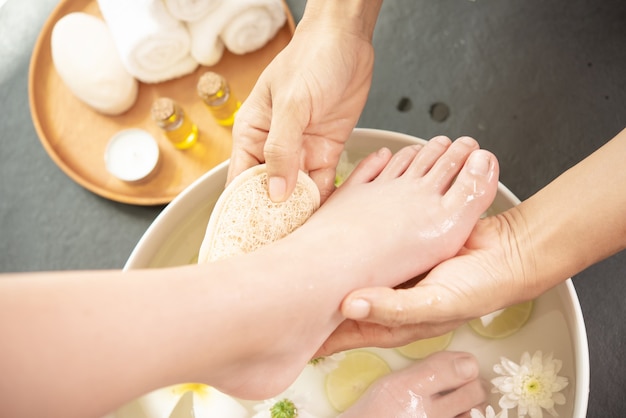Simple Ways to Hydrate your Feet
Hydration is a must for the skin. The skin can absorb the water vapour in the air, which is a step towards keeping your skin hydrated.
Why hydrating your feet is essential?
Sweat contains salt and minerals that can be lost if you don't drink enough water. When you sweat, the excess fluid goes into your bloodstream, causing dehydration and fatigue. Dehydration can also lead to cramps, headaches and other symptoms of hyponatremia (when the body loses too much sodium).
Is hydrating your feet necessary in winter also?
The most important thing you need to know is that hydrating your feet is necessary for summer and year-round. If you have dry feet, hydrate them and ensure they stay moisturized all day. If you are still determining how much water should be consumed in a day, it's best to speak with your doctor or a nutritionist who can tell you what water is good for your body and which amount might not suit you.

Generally, your feet should drink more than less regarding hydration. This is especially true in summer when humidity levels are high — extra moisture will help keep them from getting too hot and sweaty. Conversely, if you live in a dry climate with low humidity levels, you may not need as much hydration as you would if you lived somewhere with higher humidity levels.
Simple tips to hydrate your feet:
Drinking adequate water:

Drinking adequate water is the easiest way to keep your feet healthy. But it's not just about drinking more water — it's about choosing the right type of water. Most of the population drink bottled water, which provides a cheap and easy way to hydrate your body but also has drawbacks. Bottled water is often filled with chemicals and other contaminants, including fluoride and iodine, neither of which are good for you.
To ensure proper hydration, drink filtered tap water or one with a similar mineral content to what you would get from mountain streams or a well in your home country.
Foot bath:

A foot bath helps to moisturize your feet and reduce the appearance of cracks, calluses and dryness around the heels. It also helps in strengthening the nails and preventing further damage. You can make this at home easily by pouring some warm water into a basin with some Epsom salt added. Soak your feet for 15 minutes every day for 2-3 weeks and see results within a month.
Hydration foot masks:

If you have dry, cracked heels or feet, this mask will help hydrate them. Add some coconut oil, lemon juice and honey to a bowl. Mix everything very well and apply the mixture on your feet. Let it sit for 15 minutes, and wash it off with lukewarm water. If you want to remove dried-out dead skin on your heels, use this mask once every week for 3 months. If you run out of time, you can use natural, toxin-free foot mask soaks, like Dr Foot's hydrating foot mask. This is one of the best foot masks that contain hyaluronic acid, cocoa, shea butter, and aloe vera gel and leaves no side effects on your skin.
Pumice stone:

Pumice stone is ideal for removing dry skin from your feet. Just apply the pumice to your feet and massage until you see white flakes on your skin. Then, rinse off with warm water and pat dry with a towel. This will help remove dead skin cells and make your feet feel soft and smooth again. It's a simple process that takes about 15 minutes, but you'll feel like you've been given a pedicure. The pumice stone breaks up dead skin cells and debris, making your feet feel smoother and supple after use.
Natural exfoliation:
Exfoliating your feet helps remove the dead skin cells built up on your skin's surface. This makes them smoother, softer and less susceptible to cracks or ingrown hairs! You can use a natural exfoliating cream like coconut oil or shea butter on dry skin, or you can do it using a foot scrubber. Just make sure to apply some moisturizer afterwards because removing all the dead skin will leave your feet dryer than it should.
Aloe vera gel:
If you're looking for a natural way to hydrate your feet, then aloe vera gel is exactly what you need. Just apply the gel onto the tops of your toes, heels, arches and sides of your feet while wearing socks or pantyhose so that it doesn't get into any cuts or cracks in your skin.
Foot file:
Using a foot file regularly will help remove dead skin from your heels or any other part of your feet that needs extra attention, such as dry heels or cuticles etc. Use this twice weekly for 2-3 minutes until the dead skin is removed completely.









